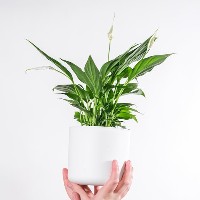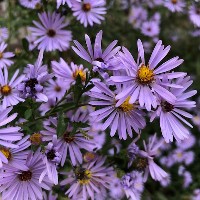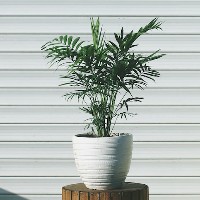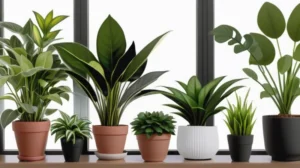Studies have shown that plants can help to remove toxins and pollutants from the air, making them an effective natural solution for improving indoor air quality.
If you’re concerned about the air you and your family are breathing, adding some plants to your home could be a simple and effective solution.
We’ll dive into the science behind how plants purify the air, and provide tips for selecting and caring for air purifying plants in your home.
“A review of the air purification efficacy of indoor plants” by William Wolverton and James B. Smith (https://www.ncbi.nlm.nih.gov/pmc/articles/PMC4062752/)
This study, published in the Journal of Environmental Horticulture, reviewed the results of several previous studies on the air purification efficacy of indoor plants. The authors concluded that certain types of plants are effective at removing a variety of indoor air pollutants, including volatile organic compounds (VOCs) and formaldehyde.
TABLE OF CONTENTS (show)
Nature’s Solution: How Houseplants Can Improve Your Home’s Air Quality
Did you know that the air inside your home could be more polluted than the air outside?Indoor air pollution is a common problem, and it can have serious health consequences if left unchecked.
Fortunately, there is a simple and natural solution: plants.
The Many Benefits of Indoor Plants for Air Quality
Indoor plants are effective at removing toxins and pollutants from the air, providing oxygen, increasing humidity, reducing stress, and enhancing aesthetics, making them a simple and natural solution for improving indoor air quality.
Removing toxins and pollutantsIndoor plants are able to absorb and filter out a variety of toxins and pollutants from the air, including volatile organic compounds (VOCs) and formaldehyde. This can help to improve the overall air quality in your home, and reduce the risk of health problems associated with indoor air pollution.
Providing oxygenIn addition to removing pollutants from the air, plants also release oxygen as a byproduct of photosynthesis. This can help to freshen the air and improve overall indoor air quality.
Improving humiditySome plants, such as ferns and bamboo palms, are known for their ability to increase humidity in the air. This can be especially beneficial in dry, air-conditioned environments, where low humidity can cause respiratory problems and dry skin.
Reducing stressIn addition to their air purifying abilities, plants can also have a calming effect on the mind and body. Studies have shown that being around plants can help to reduce stress and improve overall well-being.
Enhancing aestheticsFinally, indoor plants can add a touch of greenery and beauty to your home, making it a more pleasant and inviting place to be.
Creating a Lively Indoor OasisNow that you know the benefits of indoor plants, such as improving air quality and enhancing the aesthetic of your home, it’s time to choose the right plants for your space based on the available light, temperature, and humidity conditions, as well as the size and style of your home.
Choosing the Right Plants for Your Home
If you’re looking to bring some greenery into your home and improve the air quality at the same time, choosing the right plants is key.
Indoor plants can help remove pollutants and excess carbon dioxide from the air, making your home a healthier place to be. But with so many plants to choose from, how do you know which ones will thrive in your home and help improve the air quality?
Plants for Clean Air: How to Choose the Right Indoor Plants for Purification
If you’re looking to bring some greenery into your home and improve the air quality at the same time, it’s important to choose plants that are effective at purifying the air.
We provide tips for selecting plants that are known to be effective at removing specific pollutants from the air, such as spider plants, peace lilies, and snake plants.
We’ll also discuss the light, size, and care requirements of these plants to help you choose the best plants for your home.

- Consider the light conditions in your home: Different plants have different light requirements, so make sure to choose plants that will thrive in the available light conditions in your home. For example, spider plants, peace lilies, and snake plants can all tolerate low to medium light levels, making them suitable for rooms with indirect or filtered light.
- Think about the size and style of your space: Choose plants that will fit in your space and match your decor. For example, spider plants have long, trailing vines that can be used to create a lush, tropical look, while peace lilies have large, glossy leaves and elegant white flowers that can add a touch of sophistication to a room.
- Consider the care requirements: Some plants are easier to care for than others, so choose plants that fit your lifestyle and level of expertise. For example, spider plants are relatively low maintenance and can be easily propagated by rooting the plantlets that grow on the ends of their stems, while peace lilies require more frequent watering and fertilizing to keep them looking their best.
- Research the plant’s air purification capabilities: Look for plants that have been shown to be effective at removing specific pollutants from the air. For example, spider plants are known to remove formaldehyde and xylene from the air, while peace lilies are effective at removing benzene and trichloroethylene.
- Don’t forget about aesthetics: While air purification is important, you also want to choose plants that you find aesthetically pleasing. Consider the size, shape, and color of the plants, as well as how they will fit in with your home’s decor.

(Chlorophytum comosum)
Spider plants
Light: Spider plants prefer indirect or filtered light, making them suitable for rooms with windows that receive partial or dappled light. They can also tolerate low light conditions, making them a good choice for rooms with minimal natural light.
Care: Spider plants are relatively low maintenance and easy to care for. They prefer well-draining soil and should be watered when the top inch of soil feels dry. They can tolerate a range of temperatures, but they do best in a room with a consistent temperature between 60-75°F.
Purification: Spider plants are known to be effective at removing formaldehyde and xylene from the air, making them a good choice for homes with high levels of these pollutants. They are also known to improve indoor air quality by increasing humidity levels and reducing carbon dioxide levels.
Overall, spider plants are a great choice for those looking for an easy-care plant that can improve indoor air quality.

(Spathiphyllum)
Peace lilies
Peace lilies (Spathiphyllum) are popular indoor plants known for their elegant white flowers and ability to purify the air. They have glossy, dark green leaves and produce white, lily-like flowers that add a touch of sophistication to a room.
Light: Peace lilies prefer low to medium light levels, making them suitable for rooms with indirect or filtered light. They can tolerate low light conditions, but they may not produce as many flowers in these conditions.
Care: Peace lilies are relatively easy to care for, but they do require more frequent watering and fertilizing than some other indoor plants. They prefer well-draining soil and should be watered when the top inch of soil feels dry. They also benefit from regular fertilization with a balanced, water-soluble fertilizer.
Purification: Peace lilies are known to be effective at removing benzene and trichloroethylene from the air, making them a good choice for homes with high levels of these pollutants. They are also known to improve indoor air quality by increasing humidity levels and reducing carbon dioxide levels.
Overall, peace lilies are a great choice for those looking for an elegant plant that can improve indoor air quality. They do require a bit more care than some other indoor plants, but their beautiful flowers and air purification capabilities make them well worth the effort.

(Sansevieria trifasciata)
Snake plants
Snake plants (Sansevieria trifasciata) are popular indoor plants known for their hardy nature and ability to purify the air. They have tall, upright leaves that are often variegated with shades of green, yellow, and white, and they are sometimes referred to as “mother-in-law’s tongue” because of their sharp, pointed leaves.
Light: Snake plants are very tolerant of a wide range of light conditions, making them suitable for almost any room in the house. They can tolerate low light levels, but they will also thrive in brighter, indirect light.
Care: Snake plants are known for their low maintenance and hardy nature, making them one of the easiest indoor plants to care for. They prefer well-draining soil and should be watered when the top inch of soil feels dry. They can tolerate a range of temperatures, but they do best in a room with a consistent temperature between 60-75°F.
Purification: Snake plants are known to be effective at removing formaldehyde, xylene, and toluene from the air, making them a good choice for homes with high levels of these pollutants. They are also known to improve indoor air quality by increasing humidity levels and reducing carbon dioxide levels.
Overall, snake plants are a great choice for those looking for a low-maintenance plant that can improve indoor air quality. Their hardy nature and ability to tolerate a wide range of light conditions make them a popular choice for busy individuals or those new to plant care.

(Hedera helix)
English ivy
English ivy (Hedera helix) is a popular indoor plant known for its ability to purify the air and add a touch of greenery to a room. It has small, glossy leaves and can be grown as a trailing plant or trained to climb a trellis or other support.
Light: English ivy prefers indirect or filtered light, making it suitable for rooms with windows that receive partial or dappled light. It can tolerate low light conditions, but it may not grow as well in these conditions.
Care: English ivy is relatively easy to care for, but it does require regular watering and fertilizing to keep it looking its best. It prefers well-draining soil and should be watered when the top inch of soil feels dry. It also benefits from regular fertilization with a balanced, water-soluble fertilizer.
Purification: English ivy is known to be effective at removing formaldehyde and benzene from the air, making it a good choice for homes with high levels of these pollutants. It is also known to improve indoor air quality by increasing humidity levels and reducing carbon dioxide levels.
Overall, English ivy is a great choice for those looking for an easy-care plant that can improve indoor air quality and add a touch of greenery to a room. Its versatility as a trailing or climbing plant makes it a popular choice for a variety of settings.

(Gerbera jamesonii)
Gerbera daisies
Gerbera daisies (Gerbera jamesonii) are popular indoor plants known for their bright, colorful flowers and ability to purify the air. They have large, daisy-like flowers that come in a variety of shades, including red, orange, yellow, and pink.
Light: Gerbera daisies prefer bright, indirect light, making them suitable for rooms with windows that receive plenty of natural light. They can tolerate low light conditions, but they may not produce as many flowers in these conditions.
Care: Gerbera daisies are relatively easy to care for, but they do require regular watering and fertilizing to keep them looking their best. They prefer well-draining soil and should be watered when the top inch of soil feels dry. They also benefit from regular fertilization with a balanced, water-soluble fertilizer.
Purification: Gerbera daisies are known to be effective at removing benzene and trichloroethylene from the air, making them a good choice for homes with high levels of these pollutants. They are also known to improve indoor air quality by increasing humidity levels and reducing carbon dioxide levels.
Overall, gerbera daisies are a great choice for those looking for a colorful and easy-care plant that can improve indoor air quality. Their bright flowers add a touch of cheer to any room, and their air purification capabilities make them a functional addition to your home.

(Chamaedorea seifrizii)
Bamboo palm
Bamboo palm (Chamaedorea seifrizii) is a popular indoor plant known for its tropical look and ability to purify the air. It has slender, upright leaves that resemble bamboo stalks and can add a touch of the tropics to any room.
Light: Bamboo palms prefer medium to bright indirect light, making them suitable for rooms with windows that receive plenty of natural light. They can tolerate low light conditions, but they may not grow as well in these conditions.
Care: Bamboo palms are relatively easy to care for, but they do require regular watering and fertilizing to keep them looking their best. They prefer well-draining soil and should be watered when the top inch of soil feels dry. They also benefit from regular fertilization with a balanced, water-soluble fertilizer.
Purification: Bamboo palms are known to be effective at removing formaldehyde, xylene, and toluene from the air, making them a good choice for homes with high levels of these pollutants. They are also known to improve indoor air quality by increasing humidity levels and reducing carbon dioxide levels.
Overall, bamboo palms are a great choice for those looking to add a tropical touch to their home and improve indoor air quality. Their easy care and ability to tolerate a range of light conditions make them a popular choice for busy individuals or those new to plant care.
Combining the Right Plants for Optimal Air Purification
It’s generally a good idea to have a variety of plants in different rooms, as each type of plant may be effective at removing different types of pollutants.
For example, snake plants and bamboo palms are known to be effective at removing formaldehyde, xylene, and toluene, while peace lilies and gerbera daisies are effective at removing benzene and trichloroethylene.
By having a variety of plants throughout your home, you can create a more effective air purification system that targets a range of pollutants.
Strategies for Improving Indoor Air Quality
Improving indoor air quality is an important aspect of creating a healthy home environment.
In addition to using plants, which are known to be effective at removing a variety of pollutants from the air, there are several other strategies that can be effective in creating a healthier indoor environment.
From using air purifiers to selecting non-toxic cleaning products and considering the materials used in your home, there are many ways to create a space that is free from pollutants and allergens.
- Use air purifiers:
Air purifiers can be an effective way to remove pollutants and allergens from the air. Look for models that are designed to remove specific types of pollutants, such as formaldehyde or pet dander. Some air purifiers use HEPA filters, which are capable of trapping particles as small as 0.3 microns. Others use activated carbon filters, which are effective at removing gases and odors. Choose an air purifier that is appropriate for the size of your space and the specific types of pollutants you want to remove. - Open windows:
When the weather permits, open windows to allow fresh air to circulate throughout your home. This can help to dilute indoor pollutants and reduce the overall concentration of contaminants in the air. If you live in an area with high levels of outdoor pollution, it may be necessary to use air purifiers in addition to opening windows to ensure that the air in your home is clean and healthy. - Use non-toxic cleaning products:
Many traditional cleaning products contain chemicals that can contribute to indoor air pollution. Choose non-toxic alternatives, such as vinegar and baking soda, to help reduce the level of pollutants in your home. Avoid using products that contain volatile organic compounds (VOCs), as these can contribute to poor indoor air quality. - Consider the materials used in your home:
The materials used in your home, such as flooring, paint, and furniture, can also contribute to indoor air pollution. Look for products that are low-VOC or made from natural, non-toxic materials to help reduce the levels of pollutants in your home.
Conclusion
In conclusion, improving indoor air quality is an important aspect of creating a healthy and comfortable home environment.
Indoor plants are a natural and effective way to remove pollutants from the air, and by choosing a variety of plants that are effective at removing different types of contaminants, you can create a more effective air purification system.
In addition to using plants, there are several other strategies that can be effective in improving indoor air quality, such as using air purifiers, opening windows, and using non-toxic cleaning products. By taking a holistic approach to improving indoor air quality, you can create a healthier, more comfortable indoor environment for you and your family.
We encourage you to consider adding some plants to your living space and implementing other strategies for improving indoor air quality. Not only will this improve the overall health and well-being of you and your family, but it can also help to create a more aesthetically pleasing and enjoyable living environment.
With a little bit of research and planning, you can create a home that is both beautiful and healthy.






